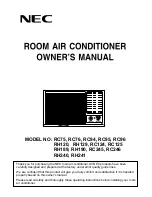
20
SERVICE
MAINTENANCE
Filters
must be checked at least once each month on
commercial operations. It is not recommended that filters
be allowed to load entirely with dirt before replacement
since this practice will permit excess dirt to foul the cooling
coil and introduce service problems by reducing air flow.
Provisions have been made for ease in changing these
items.
Belts and Pulleys
should be checked whenever filters are
changed. Make sure belts and setscrews are set tight.
Check for wear, cracking, alignment, tension and motor
amperage.
Condensate Drains
should always be checked whenever
filters are changed to ensure the condensate is draining
properly.
Condensate Drain Pan
should be cleaned and flushed
every six months.
Bearings
require no maintenance since sealed ball
bearings are used in the blower motor and condenser fan
motors. Lubrication is thus provided for the life of the
bearing.
Finishing of the sheet metal parts are done by painting in
an Electro-deposition paint system for a dipped and baked
enamel finish. Appearance can be restored with
automotive wax.
Harsh Environment.
Units furnished with the harsh
environment protection option; it is imperative to clean and
inspect the cabinet, coils and components on a semi-
annual basis. Use a chemical cleaning agent to neutralize
the contaminant. Then rinse thoroughly. Fresh water
rinsing alone doesn’t not constitute cleaning.
Controls require no routine maintenance. The points on the
compressor contactors will become discolored through
usage, but it will not effect system operation, Do not dress
or file contact points. Should a surge of power or unusual
condition damage points, replace them with identical items
from the manufacturer.
PARTS SECURITY CHECK
Before leaving an installation or operating the unit,
determine whether any loose parts should be tightened.
Failure to do this may lead to noisy operation.
Check all setscrews on blowers and fan blades.
Adjust and tighten all thrust collars.
Adjust all belts and check drives.
Retighten all electric connections.
PROCEDURE FOR COMPRESSOR REPLACEMENT
It is standard practice to install a liquid line drier in a
commercial split system. New system must be evacuated
as outlined on page 14 to remove air and non-
condensables in the system. The liquid line drier will trap
any moisture left in the system.
System cleaning after compressor failure or burnout.
Isolate the compressor and remove the refrigerant from
system.
Remove the inoperative compressor.
Install a properly sized suction line filter-drier in the
compressor suction line and replace liquid line drier.
Examine expansion valves and solenoid valves to see if
cleaning or replacement is required.
Install the replacement compressor.
Evacuate the compressor and system to 500 microns.
Open the compressor service valves and charge the
system with R-410A after compressor evacuation. See
page 18 for instructions on initial start-up procedures.
Operate the system. Check the pressure drop across the
suction and liquid drier after the first 1 1/2 hours of
operation. Pressure drop across a liquid line drier should
not exceed 5 PSI and the suction line filter-drier should not
exceed 3 PSI.
After 8 to 24 hours, take an oil sample and test with an
acid test kit. If the oil dirty or acidic, change the suction line
and liquid line filter drier and recheck after 8 hours of
compressor operation.
After two weeks, recheck oil acidity to see if another
change of suction line and liquid line filter-drier is
necessary.
In some cases non-condensable gases are produced
during the burnout. Compare the equalized head pressure
with the pressure (equivalent) to the outdoor temperature.
If the pressures are different, then the system should be
purged.
System cleaning after compressor mechanical
failures:
Mechanical compressor failures such as oil
pump, valve plates, etc. may not necessarily contaminate
the system. Check oil of defective compressor by means of
an oil acid kit and check compressor for shorts, grounds
and continuity- if all checks negative, then it is only
necessary to evacuate replacement or repaired
compressor and install a new liquid line drier. Make an
acid test after 8 hours of operation.
ORDERING PARTS
When reporting shortages or damaged parts, give the
complete unit model
and
serial number which is stamped
on the unit rating plate. These units are made special to
order and the following parts list should only be used as a
guide. Do not order parts from these lists.
Содержание RCA051
Страница 8: ...8 DIMENSIONS...
Страница 9: ...9 DIMENSIONS Continued...
Страница 10: ...10 DIMENSIONS...
Страница 11: ...11 DIMENSIONS Continued...
Страница 14: ...14 TYPICAL FIELD WIRING DIAGRAM...
Страница 17: ...17 FIELD WIRING DIAGRAM...
Страница 24: ......
Страница 26: ...26 NOTES...
Страница 27: ...27 NOTES...
Страница 28: ...28...









































